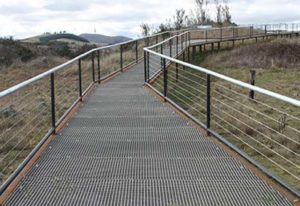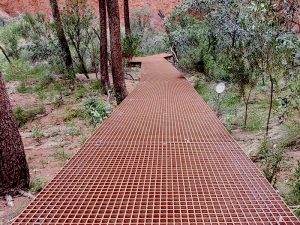There’s no denying that because boardwalks made of wood have been around for such a long time, they have become the default material that boardwalk designers and specifiers automatically think of when designing boardwalks. But is wood really the best material that could be used these days with more modern alternatives now commonly available which have excellent characteristics for demanding outdoor environments?
Take Fiberglass Reinforced Plastic (a composite material made from layered glass fibers and reinforced plastic), for example. FRP is as lightweight as aluminum, 40% as heavy as steel and only 20% as heavy as concrete. It is highly impact resistant, has a very high strength to weight ratio, more resilience than steel and flexes without cracking or breaking.
So, let’s look at how wood stacks up against four of the primary alternative materials (FRP grating, steel grating, composite wood and pre-cast concrete) in terms of the most important factors with boardwalk decking, namely strength, durability, safety, longevity, low maintenance and overall lifetime cost.
PRESSURE TREATED SOFTWOOD
| Advantages | Disadvantages |
| Most familiar material with contractors | Prone to decay and/or insect attack |
| Typically readily available near to job sites | Can crack, warp and twist |
| Can be easily cut to precise size on site | Slippery when wet |
| Easy to carry on site without heavy equipment | Higher ongoing maintenance costs |
| Relatively low cost | Algae and moss growth increase slippage |
| ‘Natural’ appearance | Concerns about leaching of preservative chemicals |
| Readily recyclable | Low fire resistance |
| Moderate lifetime only – 10-15 years |
FIBERGLASS (FRP) GRATING
| Advantages | Disadvantages |
| Exceptionally slip resistant in wet, dry or icy conditions | May be more expensive than wood |
| Open mesh allows sunlight and water to reach vegetation below | More ‘natural’ look of wood may be preferred |
| Fiberglass decking is excellent in marine environments – unaffected by salt spray | Non-biodegradable |
| Lighter than steel or concrete – relatively easy to carry onto site | Unfamiliarity with specifiers and contractors |
| Large fiberglass grate panels can speed installation | |
| Can be cut to size on site | |
| Rated Class A for fire resistance | |
| Can be supplied in colors to match surrounding environment | |
| Can construct inclined access ramps with no slip danger | |
| Excellent for steps and stairs. |
COMPOSITE WOOD
| Advantages | Disadvantages |
| Can be carried on site without heavy equipment | Low structural strength – requires additional joists to support |
| Typically readily available near to job sites | Slippery in cool, wet climates |
| Can be easily cut to precise size on site | Can be extremely flammable |
| Available in a range of colors | Relatively soft – susceptible to scratches |
| Generally non-renewable and non-biodegradable | Susceptible to mold, moss & mildew |
| Historical issues with fading & warping |
STEEL GRATING
| Advantages | Disadvantages |
| Grid allows sunlight to reach vegetation below | Subject to corrosion and degeneration over time, especially in marine environments |
| Galvanized steel has a design life expectancy of 50+ years in non-marine environments. 20-25 years in coastal environments | Typically requires heavy equipment for installation |
| Non-combustible | Can’t be cut to size on site- pre-fab needed |
| Very good slip resistance | Relatively expensive |
| High impact strength | |
| Construct inclined access ramps with no slip danger | |
| Excellent for steps & stairs |
PRECAST CONCRETE
| Advantages | Disadvantages |
| High slip resistance | Cannot be hand carried on site |
| Very good durability – 50+ years | Requires pre-defined boardwalk alignment |
| Non-combustible | More expensive than most alternatives |
| High impact strength | More difficult to transport |
All things considered, it’s hard to deny the significant benefits of FRP grating for constructing boardwalks or surfaces for small bridges on bike tracks and trails, wetland walks and suchlike, especially its exceptional slip resistance, the broad, level surface of the panels, its fire resistance and its durability. And it’s not just in coastal environments or wet and humid wetlands that the benefits of fiberglass decking shines through. Even in desert regions or remote areas where access for major maintenance due to deterioration or decay of conventional wood boardwalks may be challenging, FRP grate panels show clear advantages, with little in the way of disadvantages.
So let’s just summarize the advantages of FRP grating in general.
Durability
FRP grating holds up exceptionally well against extreme climatic conditions, surviving the most harsh, inhospitable environments and thus especially useful in wet environments such as docks, jetties and marinas. Fiberglass decking is completely immune to corrosion, unlike metal decking. It doesn’t warp or crack like wood decking and mold, mildew, and moss doesn’t grow as readily and can be more easily removed. It is not subject to attack by termites or marine borers. Typically, a lifetime of 20-50 years can be expected for fiberglass decking, depending on site conditions.
Safer Surfaces

Class A Fire Resistance
FRP decking for exterior applications includes compounds to resist both fire and UV degradation. FRP with such specifications can achieve NFPA Class A rating under ASTM E84, a flame spread index of 8 (Class A rating requires < 25 and smoke developed Index of 200 (Class A rating requires < 450). It is much more fire resistant than any wood species – hardwood or softwood.
Friendly to the Environment

The open spaces in fiberglass grating panels allow light and moisture to pass through to the vegetation underneath, enabling plants to grow and ecosystems to flourish. Also, construction of fiberglass grid boardwalks does not need heavy equipment which could damage sensitive environments – FRP grating panels can be carried on site by hand if necessary.
Aesthetic Considerations

Fiberglass Grating for Steps and Stairs

For stairs or beach access ramps however, the gritted surface which normally provides such excellent slip resistance, can prove somewhat hard on the feet for beach users. In such locations there is the alternative of supplying FRP grating panels with a meniscus finish which gives good slip resistance but is not so hard on the bare feet.
Simplicity of Installation
Fiberglass decking is normally supplied as large panels, typically 8” x 4’ rather than single deck boards which need to be fixed individually to bearers.
T0 install fiberglass grating panels you just need to lay the panels over the support bearers, making sure that the support structure is level with no high points that could prevent the FRP panels from lying flat.
To attach the panels to the bearers, either clips or screws can be used, depending on the nature of the support structure. Clips will normally be used if installing over steel ‘H’ beams for example, whereas screws may be used if installing over wood bearers, countersunk into the grating surface. To connect the panels together securely, ‘C’ clips are normally used, typically needing to be spaced only at 4’ intervals.
If any grating panels need to be cut, you can use either a power saws or an angle grinder. Proper protection precautions should always be taken when cutting or trimming FRP panels, such as wearing protective gloves, masks and eyewear.
Low Maintenance
Compared to other materials, and especially wood decking, fiberglass deck boards have very little need for maintenance. There’s no need for sealing, preservation chemicals or replacement of cracked or damaged boards from time to time. It won’t weather and expose dangerous splinters or twist and create a tripping hazard. It won’t build up moss or algae which can create a slippery surface. And of course, FRP grating does not rust like steel.
In summary, although wood has served for an exceptionally long time as the default material for boardwalks, it’s surely time to look at other materials, and in this respect, FRP grating exhibits an impressive array of advantages that puts it head and shoulders above competitive materials.

